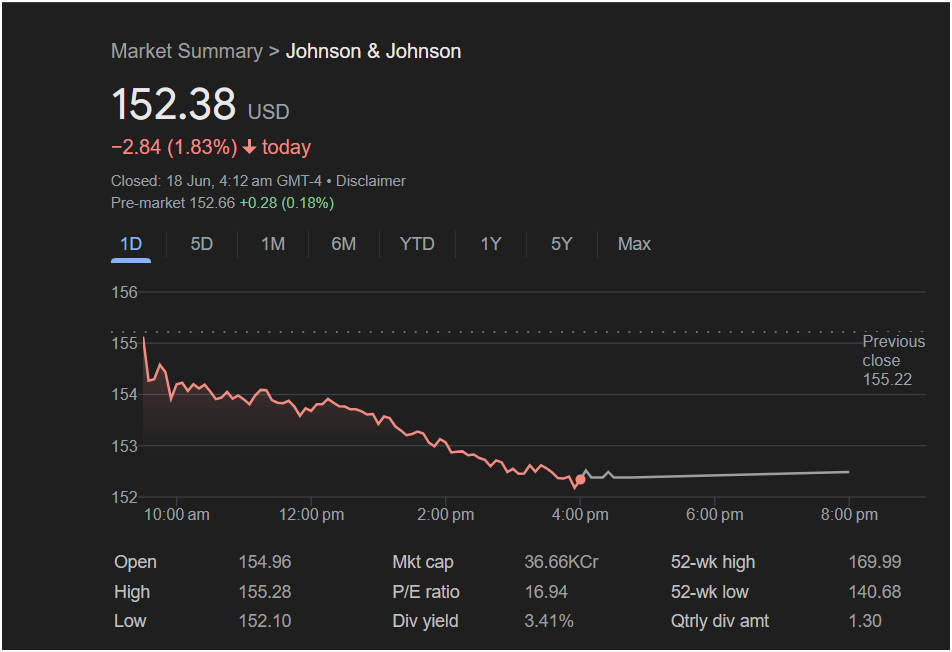Johnson & Johnson Stock Analysis: After a Sharp Drop, What Should Investors Watch Next

Carefully reviewing the latest market data for Johnson & Johnson stock (NYSE: JNJ) shows the healthcare giant faced significant selling pressure in its most recent trading session. After a notable decline, traders and investors are now closely watching pre-market activity and key technical levels to determine if a buying opportunity is emerging or if more downside is on the horizon for the upcoming week.
The Day in Review: A Steady Decline
Johnson & Johnson closed the trading day at
2.84, or 1.83%. The one-day chart illustrates a clear narrative of bearish momentum. The stock opened the day at $154.96, briefly hit a high of $155.28, but failed to sustain any upward movement. From there, it was a consistent slide throughout the session, ultimately closing very near its daily low of $152.10.

This performance stands in stark contrast to the previous day’s close of $155.22, indicating a decisive shift in sentiment.
A Glimmer of Hope in Pre-Market Trading?
Despite the rough session, there are early signs of potential stabilization. The pre-market data shows JNJ trading at
0.28 (0.18%). While this is a small increase, it suggests that some buyers may be stepping in at these lower prices, potentially setting the stage for a less volatile or slightly positive open on Monday.
Key Metrics Every Trader Needs to Know
To build a complete picture, a trader must look beyond the daily price action. Here are the crucial financial metrics from the summary:
-
Valuation (P/E Ratio): At 16.94, JNJ’s price-to-earnings ratio is not excessively high, suggesting the stock isn’t in overvalued territory, which could limit the potential for a major correction based on valuation alone.
-
Dividend Yield: With a strong dividend yield of 3.41% and a quarterly dividend payment of $1.30, JNJ remains an attractive option for income-focused investors. This solid yield can often provide a “soft floor” for a stock’s price, as yield-seeking buyers are drawn in during price drops.
-
52-Week Range: The current price of
140.68** than its 52-week high of $169.99. This can be interpreted in two ways:
-
For bears, it signals weakness and a potential test of the yearly lows.
-
For bulls, it presents a potential discount on a blue-chip company.
-
-
Market Cap: With a market capitalization of approximately $366.6 billion (36.66KCr), Johnson & Johnson is a stable, well-established company, which typically means less volatility than smaller growth stocks.
Outlook for Monday: Is It Time to Invest?
Based on the data, here is the outlook for different investment strategies:
For the Short-Term Trader:
The immediate trend is down. The pre-market bump is encouraging but not yet a confirmation of a reversal. A cautious trader might wait to see if the stock can reclaim key levels, such as the previous day’s open of $154.96, before considering a long position. The primary support level to watch below is the 52-week low of $140.68.
For the Long-Term Investor:
For those with a longer time horizon, the current situation may look more appealing. An opportunity to buy a blue-chip dividend stalwart like Johnson & Johnson at a price closer to its 52-week low could be strategic. The attractive 3.41% dividend yield provides income while waiting for a potential price recovery. A strategy of dollar-cost averaging could be particularly effective in this scenario, allowing investors to build a position over time.
While Johnson & Johnson stock ended the day on a negative note, the combination of a modest pre-market gain, a reasonable valuation, and a strong dividend yield provides a mixed but compelling picture. Monday’s opening session will be critical. If the stock can hold above its recent low and build on its pre-market gains, it could signal that the worst of the sell-off is over. However, if it breaks below the $152 level, further downside toward the 52-week low could be in play.
Disclaimer: This article is for informational purposes only and is not financial advice. All investment decisions should be made based on your own research and risk tolerance.




